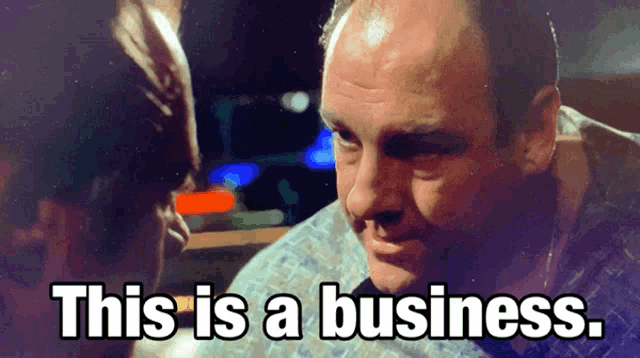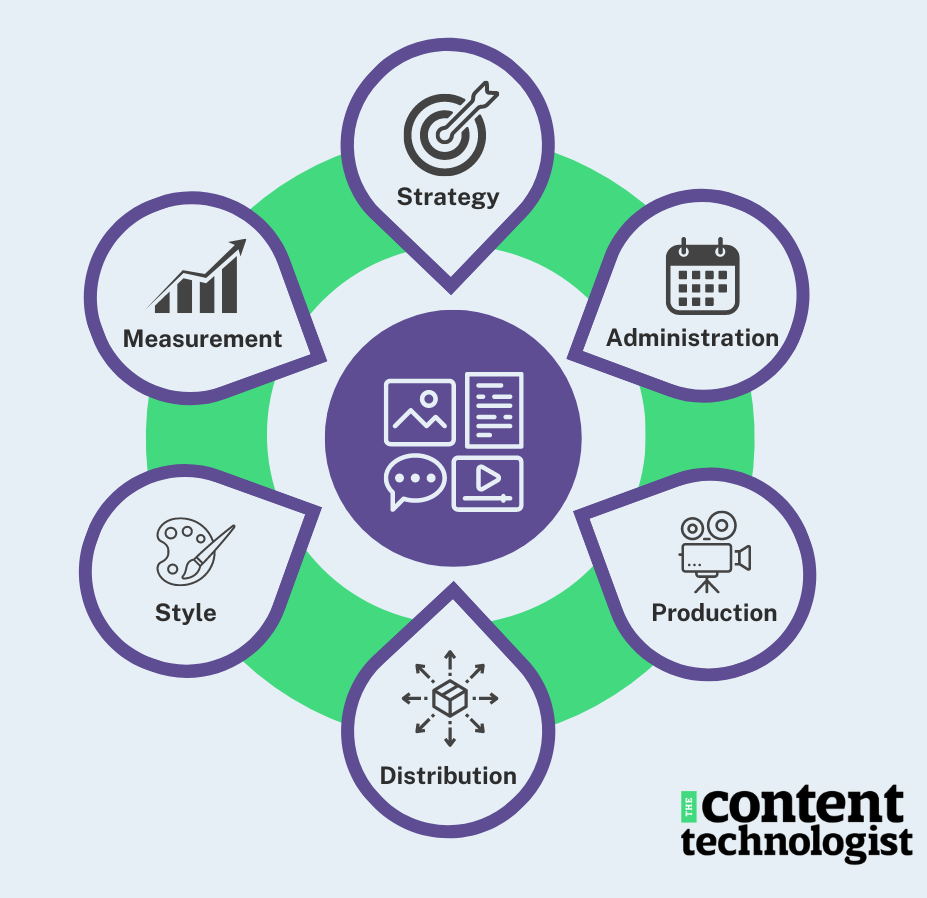How can we better elevate content strategy at the business level so that our roles, our passions, our work, and our brains are not considered replaceable?
If you ask this person

Or these people

Or this person
![Taylor Swift says, "and the more things I make, the happier I am [gif]"](https://www.content-technologist.com/content/images/2024/01/taylor-happiness.webp)
About the definition of the word “strategy,” they’ll likely talk about how strategy involves looking at the big picture to connect to their eventual goals. One wants to take over New Jersey, one Westeros, and the third, the American songbook as it connects to personal happiness. One will quote Lao Tzu, another will talk about the superiority of dragons, and the third will provide an overview of her creative process.
Only after those high-level outlines, I imagine, will these strategists dive into the technicalities of their plan.
What I’ve learned in the past few weeks is that if you ask a content professional about the definition of content strategy in 2024, it’s likely they’ll respond with some version of the words on Usability.gov, the American usability standards website. It says, “Content strategy focuses on the planning, creation, delivery, and governance of content.”
When asking content professionals directly about the definition content strategy, “planning” is the word that comes up repeatedly. Content professionals love to create a plan and call it strategy.
But I argue that planning – and its attendant resource allocation, calendars, posting velocity recommendations, style determinations, channel recommendations, voice and tone guidance — is not content strategy.
Even the most universal definition of content strategy from the landmark 2009 book, Content Strategy for the Web* by Kristina Halvorson and Melissa Rach, distinguishes the difference between strategy and planning.
“Content strategy guides your plans for the creation, delivery, and governance of content.”
[Emphasis mine.]
Strategy guides the plan, but is not the plan.
When asked to define "strategy," most of the executives in your life would likely cite a professor from their MBA program. Strategy is distinct from planning. Strategy is directional, specific to a business's needs and goals. Strategy informs the plan. But it’s not the plan itself. The plan itself is a tactic. Content strategy is no different.
Semantics! you may say. We’re content people. All we want to do is make make make according to the schedule, so we can gather those leads and traffic or whatever our business wants from us.
But, as content professionals, we literally practice semantics. Precision of language and taut storytelling are our bread and butter, so we should pay attention to the words we use.
*I assume the same definition of content strategy is in the 2009 first edition. I pulled the quote from my copy of the second edition, published in 2013.
Why content planning is not content strategy
Those of us who came up in publishing naturally veer toward “planning” because it’s in the wheelhouse we're comfortable with, happily positioned away from the dagger-eyed finance folks, and aligned with the editorial functions in 20th-century media. But that imposter syndrome – how am I supposed to know the forecasted business impact of content when I’m just a writer? – is often what holds us back.
Understanding content’s role in business separates the junior specialists from the executives. Even in contemporary publishing, when the institution preaches “separation of church and state,” senior editors, managing editors, and commissioning editors are responsible for numbers at some level. Understanding content’s role in business separates the junior specialists from the executives — and helps all content professionals maintain their careers.
When I see content professionals struggling** to be heard in business after business, or when I see independent publishers struggling to pay writers, or when I see colleagues outright rejecting algorithmic distribution, I wonder: how can we better elevate content strategy at the business level so that our roles, our passions, our work, and our brains are not considered replaceable?
But then I consider all the work that’s made my clients successful (as well as all the failures) and I see patterns of thinking that are more successful in rising above common digital business challenges.
And based on every reader I’ve talked with, every LinkedIn post I read, that there are standards content professionals have for themselves—values that aren’t always shared with the executive level—but that matter deeply in the business success of content. So we can all make a decent living, have some job security, and not feel like we’re selling our souls.
Also, selfishly, I just want to read better writing online and get out of the mire of mediocre digital content.
Let’s create a more accurate definition of content strategy, revised for the 2020s. Let’s set the plan off to the side for a minute and ask ourselves: what is the business strategy of content? How do we transform that into content strategy? What are the activities that fall under strategy versus planning and production?
**I have struggled with these in my business privately and publicly, so I see you! Publishing digitally is a massive challenge, and it takes years to build a content-first business. Having a career in content is a huge challenge, and sometimes it makes us all wish we were just happy in a discipline that seems a little more stable, like accounting.
A new definition of content strategy

Here’s how I’ve been thinking about strategy for The Content Technologist approach, which aims to explicate the goals and ultimately champion the various roles and responsibilities of digital content professionals, whether they focus on strategy, creation, research, UX, journalism, design, or one of the many other professional categories that modify the word “content.” It’s based on a career spent half in legacy publishing, half in digital strategy, and the hard lessons and business realities I’ve learned in each:
Content strategy defines why, how, where, and for whom a company creates content. It comprises the activities that connect business goals with audience (aka consumer, customer, user, or client) needs, defines content’s purpose in an organization, and specifies the conditions that make content successful.
Why am I altering this definition of content strategy from those that already exist?
- All definitions, particularly the ones that define our careers, should be a part of an evolving discussion and not set in stone by any single organization. You may take from my definition and expand upon it, add to it, and critique it. But there has never been a single answer on what content strategy is.
- Halvorson’s and Rach's definition hints at business goals but does not explicitly state the role of content in supporting a business.
The “business” aspect is important, even though it’s implied in strategy, because it elevates the role of content beyond filling in words on a page and ties it to real-world outcomes. What I’ve observed in the past ten years is that the further content is removed from business goals, the more replaceable it becomes in an organization. And one of the goals of the Content Technologist Approach is to create a direct tie to business outcomes. - The definition of content strategy above is meant to be separate from editorial strategy, which can be a part of content strategy but is specific to the publishing/content marketing business.
For example, customer support content, which is very important to many organizations, doesn't need an editorial strategy in the traditional sense. In my view, every business should have a content strategy, even if it's just for a website and a few pieces of collateral a year. Not every business needs to refine to the level of editorial strategy. - None of the existing definitions addresses audience and the data they provide that supports business goals in a digitally networked world. The core features of 21st-century digital distribution are rooted in the networked connection with its audience, versus a 20th-century mass communications broadcast approach, where the audience has no real say and is even scorned by producers. I fully believe that the audience is inextricable from business goals. So, let’s name it in the definition.
- The phrase “useful, usable content” is succinct but extremely vague. It doesn't specify for whom the content should be useful and usable, which when not explicitly defined leads to significant dissonance between the executive level and production, or even among content teams. “Useful” and “usable” shifts for every audience.
Not every piece of content is designed to be global and universal; not every piece of content needs to be laden with voice and uniqueness; and not every piece of content that performs for a business needs to be “useful” in a traditional sense. - “Planning,” for reasons I’ve identified above, follows content strategy, but is not a part of the strategic activity itself. In The Content Technologist approach, planning is spread across the administrative, production, and distribution functions, but is separate from strategy.
Content strategies vary for different types of businesses. Some businesses only need messaging frameworks for occasional collateral and social media posts. Many need customer-support-oriented content strategies to keep their existing user base happy. Other businesses publish content as a part of their customer acquisition and marketing process. Many nonprofit and cultural organizations are mandated by their endowments to maintain archives of their content. Still other businesses are media companies, whose sole purpose is to create and distribute content.
All need to address the why, how, where, and for whom of content strategy, but they require different strategies for their business needs.
The activities that comprise content strategy
What activities are part of content strategy, according to this approach? Anything that supports a content’s why, or its purpose, for a business. A partial list includes:
- Defining content strategy within an organization, of course. I defer entirely to Content Strategy for the Web on the best methodology for creating a content strategy statement.
- Audience research, both qualitative and quantitative. This includes keyword research, user interviews, channel performance analysis, creating personas or profiles, defining dat collection opportunities for personalization, and other activities that involve understanding what an audience needs from content.
- Creating information architecture, format development, content typology, and messaging frameworks that guide broader content initiatives, whether those are website architecture designs or advertising and marketing campaigns.
- Brand values and content alignment, via defining content pillars or research frameworks that function in an organization. Activities around brand values may also address the role of artificial intelligence in creating content for an organization, although most AI-related activities also fall in administration and production.
- Identifying what success looks like, either via key performance indicators (KPIs), objectives and key results (OKRs), or just plain statements that identify what success looks like for content at the business level.
- Acknowledging content’s challenges and opportunities at a business level. Another brilliant content strategist, Lauren Pope, creates spaces entirely for challenges and opportunities in her content strategy canvas, which I love.
- Understanding where a business’ content adheres to and deviates from industry norms. Content is fundamentally a creative discipline, but understanding the boundaries of that creativity is crucial for business consistency and success.
- Defining content’s purpose, substance, and team structure at an organizational level. What does content do at an organization, and which departments are responsible? What is content saying at an organizational level?
Notice I don’t say “governance” here, not only because I have a well-acknowledged problem with institutional authority, but also because content people can be shoeboxed into the role of an elementary school teacher with a red pen or “grammar police,” and that’s not a way to set yourself up for success at a business level. As I've written before, collaboration is the expectation in 21st century businesses, and "governance" connotes top-down authority. I much prefer purpose, substance, and structure, which are more positive terms.
And whether you identify as a Tony Soprano, Daenerys Targaryen, or Taylor Swift-type strategist (I kinda hope we’re all Taylors, specifically for the “never did a murder and is a real person” factor), you now have a new definition to take your content beyond a simple plan. You are no longer just making. You are acquiring the tools to strategize and elevate your work at the business level.
Thanks for Brain Traffic, Lauren Pope, Erin Schroeder of Lullabot, Michelle Keller, the Nielsen Norman Group, friends/clients at Storythings, everyone who contributed to this LinkedIn discussion, and everyone writing about content strategy online for contributing to this discussion, directly or indirectly.
Hand-picked related content








